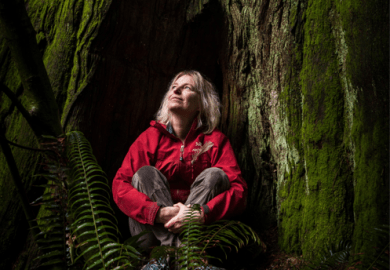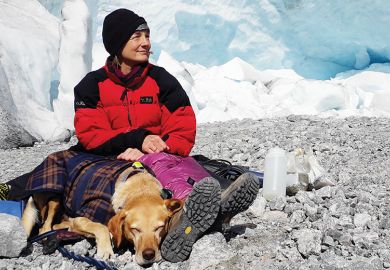The publication of this satisfyingly thick tome results from a collaborative research programme between Russian, Mongolian and western vertebrate palaeontologists, sponsored by the Royal Society and the Russian Academy of Sciences. The earth sciences department at the University of Bristol and the Palaeontological Institute in Moscow ran the programme between 1993 and 1997, the first such joint venture for some 75 years. Prior to that, vertebrate palaeontology progressed in both parts of the world through the 20th century, albeit with rather few opportunities for interaction and cross-fertilisation. Most Russian research in vertebrate palaeontology has been published in Russian-language journals and monographs, held in few western libraries and with rare translations. Thus, much Russian work is inadequately known in the West and not always taken fully into account in the western literature. It is correspondingly the case that Russian work has suffered from isolation from western literature and contacts.
Those days are largely in the past, and the only significant barrier to the synergy of combined efforts is a financial one. A modest injection of funds has demonstrated what can be achieved by international cooperation: Russian, Polish, Mongolian, western European, North American and Australian palaeontologists have contributed their expertise to the 30 chapters in this book.
The title suggests that the content covers the fossil faunas of the Mesozoic era, that is the 180 million-odd years spanning the Triassic to Cretaceous periods. However, some of Russia's most significant tetrapod faunas pre-date the age of dinosaurs. Permian fossil sites abound in European Russia, east of the Urals, and have yielded a rich variety of amphibians, early archosaurs (from which dinosaurs and birds evolved) and amniotes (from which mammals ultimately derive). The last include the first diverse radiation of large-bodied herbivores (pareiasaurs and some deinocephalians) as well as more advanced Permo-Triassic faunas of herbivorous and carnivorous therapsid "mammal-like" reptiles. All of these are documented in a series of six review chapters covering systematics, one with a phylogenetic analysis (pareiasaurs), and biogeography.
A fascinating historical account of Permo-Triassic discovery and excavation introduces this part of the book. The earliest discoveries of bones in Cis-Ural copper mines - dating back to 1770 - originally thought to be the remains of ancient miners, belonged to a deinocephalian; the first scientific description of deinocephalians from the Copper Sandstones in 1838 by S. S. Kutorga (although he mistook them for mammals) means that he was the first to notice the similarity between mammal-like reptiles and mammals. The chapter continues with pen portraits of the great Russian palaeontologists of the past century, and a brief survey of the past four decades sets the scene for current work.
The next four chapters cover the Russian Triassic stratigraphical sequence that overlies the Permian in European Russia. The first of these is an updated tetrapod biostratigraphy based on fieldwork conducted during the programme. Reviews of early archosaurs and procophonoids, enigmatic small gliding reptiles preserving soft tissue structures and marine reptiles, complete the roll-call.
The remaining two-thirds of the book are devoted to Cretaceous faunas and follows the same bauplan . The history of the first Mongolian expeditions, undertaken by the American Museum of Natural History in the 1920s, will be familiar to many readers, more so by inclusion of a slightly updated version of Edwin Colbert's 1968 account from Men and Dinosaurs . Less familiar are the Russian-Mongolian expeditions between 1940 and 1990. Updates on Mongolian stratigraphy, palaeo-biogeography, litho-stratigraphy and sedimentary settings precede a series of systematic and taxonomic reviews from amphibians to mammals. The treatment is variable; some groups are covered by little more than a brief systematic checklist and diagnoses; others by extensive descriptive chapters (turtles), some supported by locality lists, maps and lengthy systematic comments (mammals). Few chapters include a phylogenetic treatment, notably that on pachycephalosaurs and ceratopians.
The western literature on dinosaurs is extensive, and many existing and forthcoming textbooks cover Russian and Mongolian material in considerable detail. Mongolia especially has been a focus of interest in recent years, with spectacular discoveries resulting from international collaborative expeditions, in addition to the Royal Society-Russian Academy of Sciences programme. The dinosaur chapters to some extent duplicate existing English-language sources, and the pace of research is such that they have already dated slightly during the gestation of the book. By contrast, one would be hard pushed to gather information covering less "popular" groups such as turtles, crocodiles, choristoderes, lizards and pterosaurs without the resources in those chapters. The contribution on Mesozoic birds is especially welcome. Russian authors have described a wide range of birds from skeletal material, feathers and eggs. These add greatly to knowledge of the early radiation of birds belonging to modern orders and much important information is brought together in the English language for the first time.
This book is definitely a case of the sum exceeding the parts. A series of introductory sections add to its usefulness. Conventions in Russian and Mongolian palaeontological literature and transliteration schemes are explained, and standardised terms for stratigraphical units and Mongolian place names are listed; transliterated names of Russian and Mongolian palaeontologists are a bonus. The editors have thoughtfully provi-ded an alphabetical listing of the relevant Russian journals. Many have a complex history of title changes: double-titles in Russian and French were in common use and retained by some bibliographies until the 1950s. These aids will make less frustrating trips to the library shelves and increase the likelihood of finding first time what one is looking for among the rows of indistinguishable runs of green and blue-backed Russian-language journals.
The book fills a niche in the scientific literature. There is no other compact and comprehensive summary of Russian and Mongolian vertebrate palaeontology between the covers of a single volume. The editors deserve congratulations for their initiative, drive and hard work. In addition, the book is attractively produced, a convenient easy-to-handle size and well bound so that it opens out flat. It is aimed at the professional, academic and library markets and at £90 may not find its way on to many personal bookshelves. That is unfortunate, for it is the obvious starting point for anyone with an interest in the fossil vertebrates of Russia and Mongolia, and my hand will reach for it whenever the need arises.
Angela C. Milner is head, fossil vertebrates and anthropology division, Natural History Museum.
The Age of Dinosaurs in Russia and Mongolia
Editor - Michael J. Benton, Mikhael A. Shishkin, David M. Unwin and Evgenii N. Kurochkin
ISBN - 0 521 55476 4
Publisher - Cambridge University Press
Price - £90.00
Pages - 696
Register to continue
Why register?
- Registration is free and only takes a moment
- Once registered, you can read 3 articles a month
- Sign up for our newsletter
Subscribe
Or subscribe for unlimited access to:
- Unlimited access to news, views, insights & reviews
- Digital editions
- Digital access to THE’s university and college rankings analysis
Already registered or a current subscriber?



